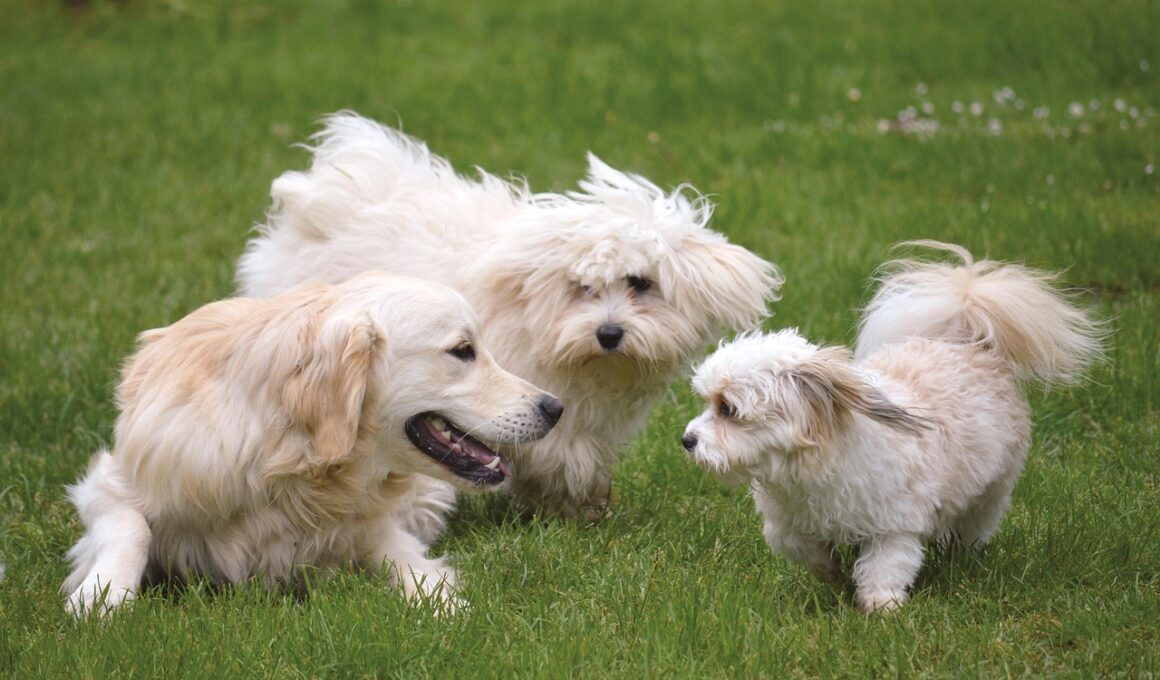How to Read and Respond to Your Dog’s Social Cues
Understanding your dog’s social cues is essential for effective communication. Just like humans, dogs express their feelings through body language and vocalizations. Observing tail movements, ear positions, and facial expressions can provide insights into your dog’s emotional state. For instance, a wagging tail typically signifies happiness, while a tucked tail may indicate fear. Furthermore, noticing how your dog interacts with other dogs and humans can help gauge their comfort levels. If your dog approaches another dog with a relaxed body, it signals friendliness, while stiff posture might indicate aggression or discomfort. To foster better communication, engage in training routines that emphasize socialization skills. Practicing commands in versatile environments helps your dog adapt to various situations and reactions from others. Regularly introducing new people and dogs can gradually increase your dog’s comfort zone. Watching how they respond and adjusting your interactions are key to building a solid relationship. Thus, investing in training, socialization, and understanding cues can lead to rewarding bonding experiences between you and your new furry friend. Ultimately, strengthening this communication foundation is crucial for a healthy and happy partnership.
Furthermore, it is important to recognize that dogs communicate differently based on their individual personalities. Some dogs may be more submissive and prefer to avoid confrontation, whereas others may exhibit more assertive behaviors. Pay close attention to your dog’s specific cues, as these can vary significantly between breeds and individual experiences. For instance, a shy dog might lower its body and avoid eye contact when feeling threatened, while a confident dog will stand tall and make direct eye contact. The key is to foster their unique personality by offering a safe space where they can express themselves freely. Observing these personality traits allows you to adjust your training techniques accordingly. Reinforcing positive behaviors with treats or praise when your dog shows confidence can be highly effective. Moreover, be mindful of environmental factors; a crowded park can elicit different reactions compared to a quiet neighborhood street. Therefore, engaging in socialization exercises in various settings will help your dog learn how to interact with diverse stimuli. Ultimately, developing a keen understanding of your dog’s unique communication style is vital for nurturing a harmonious and joyful relationship.
Decoding Dog Body Language
One of the most effective ways to decode a dog’s emotional state is through their body language. Dogs communicate predominantly through visual cues, and recognizing these signs can significantly improve your training and bonding experience. For example, a dog exposed to the tongue-flicking behavior may be feeling uncertain or anxious. On the other hand, when a dog displays a ‘play bow’ with front legs stretched forward and hindquarters raised, they are inviting you and others to engage playfully. Additionally, pay attention to how your dog holds its ears; alert ears can indicate curiosity, while flattened ears often signify fear or submission. An important aspect to consider is your dog’s overall demeanor in conjunction with body language. Dogs exhibiting relaxed body posture are generally comfortable, while stiff bodies may indicate stress or agitation. Understanding these signals will greatly enhance your training effectiveness and strengthen your bond. Furthermore, proactive responses to your dog’s body language can help alleviate stressors and enhance their confidence. Gradually, you’ll create a trusting environment that will benefit you both in social interactions and daily routines.
In addition to body language, vocalizations can also provide valuable insights into what your dog is trying to convey. Dogs may bark, whine, growl, or howl, each indicating a different emotional state or intention. For instance, happy barks often accompany playful moments, while growling may indicate discomfort or a warning. Recognizing the context in which these sounds are made is critical for accurate interpretation. Be aware of the tone and intensity of the vocalizations to understand their urgency better. For example, a high-pitched bark may communicate excitement or joy, while a lower growl may signal displeasure or a need for space. When your dog vocalizes, respond appropriately to reinforce positive behaviors and redirect negative ones. Avoid punishing your dog for barking unless prompted by behavioral issues, as this may lead to fear or anxiety. By understanding the spectrum of vocalizations in conjunction with body language, you will develop a more comprehensive understanding of your dog’s needs and emotional state. This dual approach will strengthen your communication, allowing for a more fulfilling and balanced relationship.
The Role of Socialization
Socialization is paramount in helping your dog develop healthy communication skills with both humans and other animals. Exposing your dog to a variety of environments, people, and experiences builds their confidence and teaches them appropriate behavior in different settings. Begin with controlled introductions to new experiences, gradually increasing complexity as your dog grows more comfortable. Enroll your dog in training classes that focus on positive reinforcement, where they can interact positively with other dogs. This helps establish essential social skills and reduces the likelihood of fearful or aggressive behaviors arising in unfamiliar situations. It’s critical to maintain positive experiences during these encounters. If any negative situations arise during socialization, try to manage them calmly to prevent instilling fear or anxiety in your dog. Be aware of your dog’s specific discomfort signals, and act proactively to safeguard their well-being. Consistency in positive social interactions can lead your dog to become a well-adjusted companion. For instance, well-socialized dogs typically exhibit less anxiety and aggression, making outings more enjoyable for everyone involved. Ultimately, invest time in socialization efforts, as the long-term benefits significantly outweigh the initial challenges.
Additionally, fostering friendships with other pet owners can provide both you and your dog with valuable networking opportunities. Having access to a community of dog lovers creates a supportive environment where you can share experiences, challenges, and tips to enhance your dog’s well-being. Participating in group activities, such as dog parks or organize outings, not only helps socialize your dog but also strengthens the bonds between pet owners. Forming a support system may aid in troubleshooting behavioral issues and improve your dog’s overall training experience. Consider joining local clubs or online forums to exchange knowledge and consciousness about dog care and socialization techniques, which can lead to valuable insights into effective and positive training approaches. Furthermore, engaging in playdates with other dogs can facilitate a fun and interactive learning environment. Mutual reinforcement of positive behaviors can occur naturally, guiding your dog toward appropriate social interactions. Take advantage of opportunities for your dog to observe and learn from their peers, which is often just as valuable as structured training sessions. This collaborative approach ensures a balanced socialization journey for both your dog and yourself.
Building a Balanced Environment
Creating a balanced environment for your new dog is essential for effective learning and social interaction. Dogs thrive in settings that are nurturing and predictable, allowing them to feel safe and secure. Establish a routine that outlines feeding schedules, exercise, and training sessions to help your dog understand what to expect throughout the day. Consistency helps minimize anxiety and makes it easier for your dog to adapt to their new surroundings. Furthermore, make sure your home is dog-friendly by providing designated areas for their belongings, such as beds, toys, and food dishes. It’s crucial to allow your dog to explore their space at their own pace without undue stress. Additionally, engaging them in various activities, including scent games and mental puzzles, fosters their cognitive development and eases boredom. Exercise is also indispensable; regular walks and playtime are vital for maintaining your dog’s physical health and well-being. Through active engagement and a comforting space, your dog can develop a sense of belonging and security. This ultimately leads to a more fulfilling coexistence, decreasing behavioral issues and enhancing communication between you and your pet.
Lastly, be patient and observant when acclimating your new dog to social stimuli. Transitioning to a new environment can be understandably overwhelming for a dog. Accept that building confidence and establishing social cues retains a gradual learning curve. Monitor your dog’s reactions, and celebrate their little achievements, whether it’s approaching a new friend or remaining calm during an outing. Positive reinforcement techniques, including treats, praise, and affection only encourage desirable behavior. Understand that each dog is unique, and any timelines will vary; some may adapt rapidly, while others require extended periods to feel comfortable. Engaging in gentle reassurance during unfamiliar interactions greatly enhances their sense of security. If your dog displays fearful behavior, take a step back, and let them observe from a distance until they feel ready. Additionally, consider seeking guidance from professional trainers if you need assistance with problematic behaviors or anxiety issues. This can facilitate a smoother transition, ensuring that your dog gains the necessary skills to thrive socially. Ultimately, a well-adjusted, socially adept dog will contribute to a happier household and build a rewarding relationship with you as their owner, enhancing your mutual companionship.


